Meg Mackintosh Solves Seven American History Mysteries (6 page)
Read Meg Mackintosh Solves Seven American History Mysteries Online
Authors: Lucinda Landon

“Maybe the V is upside down ⦠and it means the point of the roof?” suggested Peter.
“Let's check it out,” offered Meg, and they climbed the steep narrow stairs to the attic. They searched high and low but could not find another clue or the silver.
Then Meg noticed the symbols carved on the crossbeams: I, II, III. Each symbol on the beam matched a symbol on the rafter it was notched into. She thought about what the librarian had told her about how old houses were put together. “I've solved the mystery, Peter!” she said. “I know where Abigail Hopkins hid the silver on April 18, 1775.”
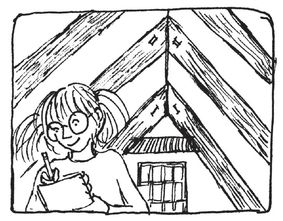
What did the âV' stand for? Where is the Minuteman's secret silver hidden?
When Meg saw the I, II, and III, she realized that they were Roman numerals and that the âV' stands for Roman numeral five. She deduced that the silver was hidden near the fifth rafter and the fifth crossbeam. She and Peter found a small tin box wedged into the space there. Meg took the key they'd found in the beehive oven and unlocked the box. Inside was a folded piece of parchment paper with the initials
W.D.
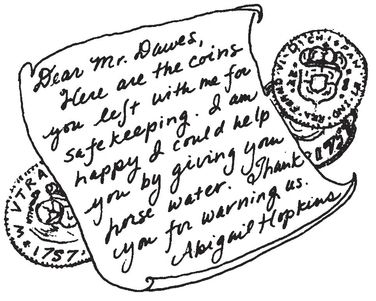
Meg unfolded the parchment and tilted it into the palm of Peter's hand â three silver coins and a tightly rolled note from Abigail spilled out.
Meg and Peter figured that Abigail hid the coins near the fifth rafter and then hid the key to the box in the beehive oven.
She might not have told her parents because she didn't want to worry them, given all the turmoil of the times.
Abigail and her family probably hid in the secret place while they feared the British were marching through town. While in hiding, Abigail left another clue to help Mr. Dawes find the coins, in case anything happened to them. Tragically, Abigail took ill with a fever shortly after that night and sewed the final clue into her sampler before she died. Her parents were probably too grief-stricken to notice the message. William Dawes may have returned for the coins, but seeing a home in mourning, he turned away. Maybe he decided that Abigail deserved the coins for helping him that fateful night.
“But why isn't William Dawes as famous as Paul Revere?” Peter wondered when they told the story to Gramps.
Gramps paused for a second, then said, “Maybe it has something to do with Longellow's poem about Paul Revere.”
“What do you mean?” asked Meg.
“Maybe Paul Revere became even more famous for the midnight ride because Longellow wrote the poem about him,” Gramps went on, “probably because it was easier to find words to rhyme with Revere than with Dawes:
Listen my children and you shall hear
Of the midnight ride of Paul Revere⦔
“Hmmm.” said Peter: “It could have been:
Listen, children, and we shall pause
To hear the story of William Dawes⦔
“You'll have to write that poem, Peter,” said Meg.
“I think I will,” said Peter. “William Dawes, unsung hero! And we'll give the coins to the Arlington Library for their historic collection.”
Continue the poem about William Dawes
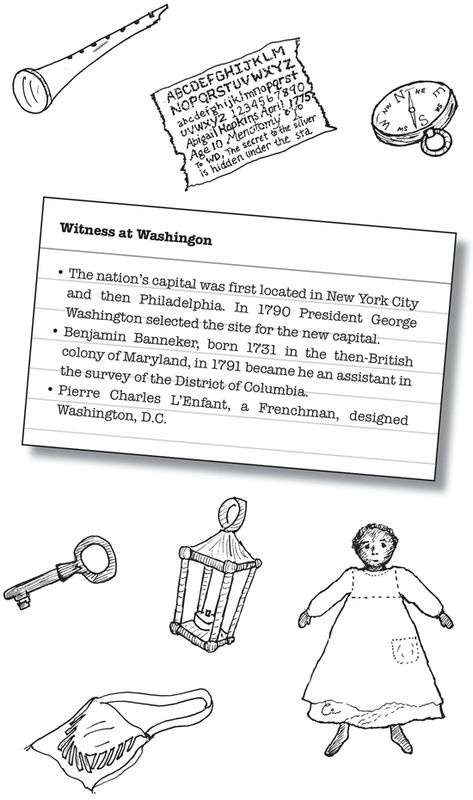
Witness at Washington
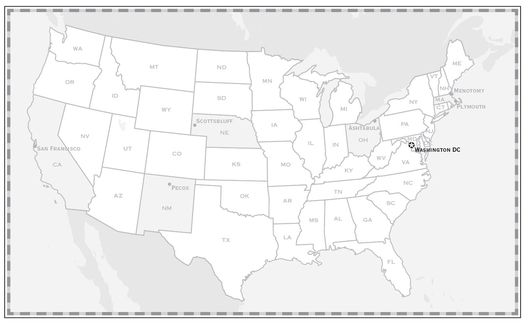
“So long Boston! From now on this history mystery tour is heading west!” Meg Mackintosh called out from the minivan.
“To be more exact, we are going southwest, down the East Coast to Washington, D.C.,” said her brother, Peter.
“This is just one of many long traveling days,” their grandfather told them. “So I'll let you get started on your next history mystery â Witness at Washington.”
“Witness to what?” wondered Meg.
Gramps peered quickly in the envelope. “There are four clues. Here's the first.”
Peter looked at the clue. “It's the cover of an old almanac.”
“What exactly is an almanac?” Meg asked.
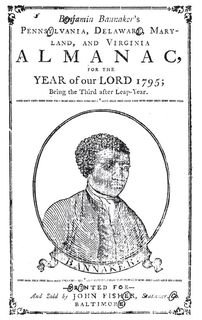
Clue 1
“An almanac is a book of facts that is published every year,” Gramps explained to them. “In old days, most people didn't own clocks or calendars, so they relied on an almanac to figure out the best time to plant and harvest crops and fish.”
“Well, I know who wrote an almanac â Poor Richard,” said Meg as she got out her notebook. “He said things like âa penny saved is a penny earned'.”
“A poor guy named Richard didn't write it,” said Peter.
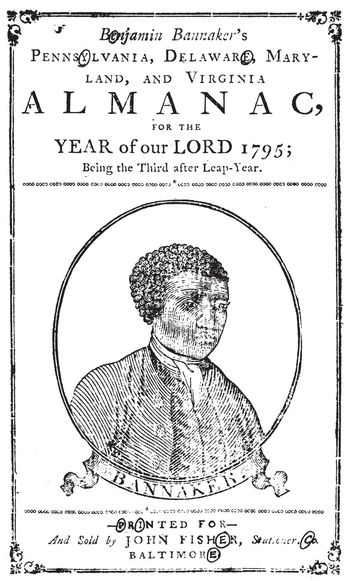
“He didn't?” Meg hated being wrong. She ignored Peter and stared at the almanac cover. Then she got out her magnifying glass. “Wait a minute. This almanac has clues all over it!”
Who wrote Poor Richard's Almanac? What clues did Meg detect? What do the circled letters spell? Who do you think is the next History mystery child?
“Poor Richard's Almanac was really written by Benjamin Franklin,” said Peter. “Poor Richard was a pen name.”
“Oh, right. I forgot,” Meg admitted.
“The author of this almanac was another Benjamin â Benjamin Banneker. There's a picture of him and his name right at the top.”
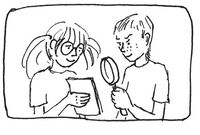
“So now we know who the next history mystery child is,” said Peter as he glanced at the list. “Ten to one it's a Robert Banneker.”
“He's got to be related to Benjamin Banneker,” Meg agreed. “There's more,” said Meg. “See the circled letters.”
Peter called out the letters, “E-Y-E-P-I-E-C-E.”
“Eyepiece?” Meg and Peter were baffled. “What could an eyepiece have to do with the history mystery? Gramps, we need more clues.”
“Okay, here are the second and third clues from the Professor,” said Gramps as he handed them into the back seat. “Maybe these will keep you busy until we get to Washington.”
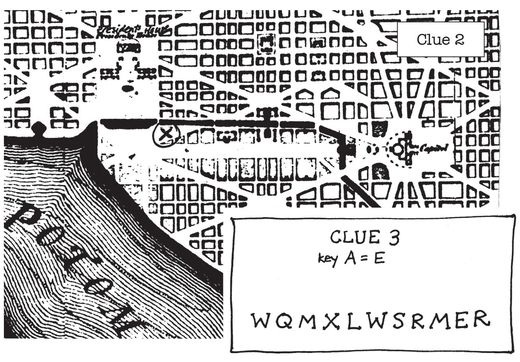
What is clue two? Can you decode clue three?
Peter stared at clue two. “This has to be an old map of Washington, D.C. It faintly says âCapitol' here.” He pointed. And the âX' must mark the spot where we're supposed to go. But everything just looks like a bunch of shapes.”
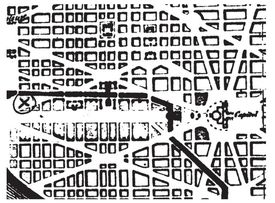
“The City of Washington was designed by a Frenchman, Pierre L'Enfant,” Gramps informed them. “He planned the city to be on a geometric grid with diagonal avenues that created rectangles, triangles, and even circles and squares for parks and gardens.”
“It's a nice design,” Meg said, glancing at the old map. Then she resumed writing in her notebook. “But I'm trying to figure out where we should go first when we arrive in Washington. This is an alphabet code and A=E.”
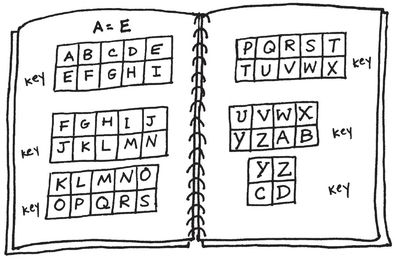
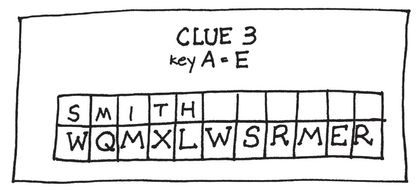
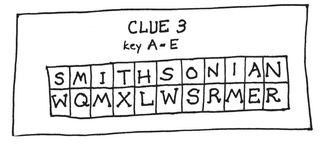
“We should go to the Smithsonian Institution.” Meg tossed her pencil in the air.
“That's exactly where I wanted to go,” said Gramps. “The largest museum in the United States!”
Peter got out a new city map of Washington to locate the Smithsonian.
“We should go to the Museum of American History at the Smithsonian for the purposes of our investigation,” he suggested.
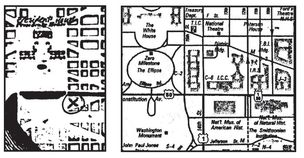
What do you notice about the location of the Smithsonian?
“Just as I thought, the Smithsonian is located at the spot marked off on the old map!” Peter blurted out.
The next morning that's exactly where they went.
